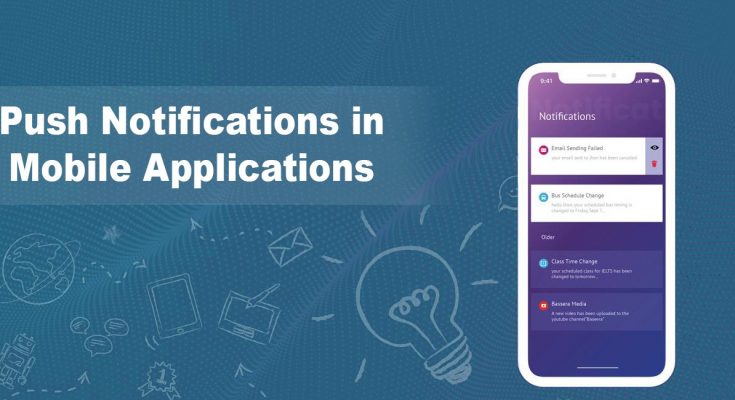Push Notification Service Providers
Push Notifications are messages that help user to be updated through their Mobile/Desktop Gadgets. These messages can be generic or customized for a specific client. Organizations can improve the client experience by sharing just customized messages, as opposed to irritating them with a wide range of conventional messages. The following conditions are before sending push notifications:
- Appropriate content dependent on client profile.
- Time-based on the user’s geographical location and time zone.
- Language is dependent on the area of the device/user.
Push notifications can be delivered to mobile devices, desktop applications, and browser applications.
Service Providers –
OSPNS (Operating System Push Notification Service) –
There are numerous Operating System Push Notification Service suppliers, for example,
- Amazon Device Messaging (ADM) – this service is utilized to send push notifications to clients of Amazon Gadgets, for example, kindle tablets and other devices that run Amazon applications.
- Apple Push Notification Service (APNS) for the two Mac OS X and iOS.
- Baidu Cloud Push (Baidu) – this helps empower you to send push notifications to a large number of cell phones in China.
- Firebase Cloud Messaging (FCM) for Android gadgets.
- Microsoft Push Notification Service for Windows Phones (MPNS).
- Windows Push Notification Services (WNS).
OSPNS gives one of a different device to send push notifications by backend application servers.
Message Service Providers –
Some of the regularly utilized cross-stage specialist organizations for push notification messages are listed below:
- Amazon SNS
- Pushwoosh
- Intercom
- Mixpanel
- Taplytics
Mobile Push Notifications –
Mobile apps are usually classified into 3 types :
- Progressive Web Apps (Html/Java-script web apps)
- Hybrid Apps (Ionic-Cordova, React Native, Flutter, Native-Script)
- Native Apps (Java/Kotlin, Objective-C/Swift)
Even though all these applications get push messages, they differ in their way of dealing with registering, receiving, and handling messages. Regardless of the type, every mobile application needs to enroll with their OSPNS to create an interesting device token, which needs to be shared with the Application backend for sending push messages to the particular devices. Each message specialist co-op has its upsides and downsides, and the application backend can utilize any of the above Push message specialist organizations for sending pushes to the client gadgets.
Registration
- In both platforms (Native and Hybrid) Applications will initially listed with OSPNS to get a unique device token
- In the case of Firebase in iOS, as an additional step, the iOS application needs to send the unique device token it gets from the APNS and get a Firebase in return. This token is utilized by FCM to send the push to the APNS and to the device at last.
- These deice tokens are transmitted with the application backend and stored in the database alongside device and user data. This will be your last step to complete Registration.
Messaging
- At the point when even occurs application backend should start a push message stream. The backend can be particular on who should get the push for this particular occasion as it has client and device data alongside gadget tokens.
- After finalizing the target audience, the backend fetches all the device tokens of that particular client or group.
- The backend should create a Push message payload. This payload will have the necessities, similar to Title, Body, Sound, Image, and some custom fields. Payload is fabricated including gadget tokens and event details. Custom fields should have the least data for the mobile app to know about the occasion. This payload may differ based on the gadget OS.
- The backend needs to discuss first with FCM the payloads for both Android and iOS platforms. After which FCM forwards the push to the APNS in the case of iOS or Android devices. If in the case of Native applications backend will send payloads directly to message servers FCM and APNS for Android and iOS individually.
- These messaging servers (FCM and APNS) will set received messages in line for shipping off the client devices and get back with success or failure responses to the backend. group of push messages can also be sent to messaging servers.
The delivery of messages can be made immediate or scheduled for the future by customizing the payload as needed. For Native applications, unification of push notifications integration is moderately easy and features like background push are effortlessly upheld which implies, that push messages arrive at the application controllers in any event, when the application isn’t in the forefront. Yet, if there should be an occurrence of Ionic applications, the application must be in the frontal area to devour message pop-up information. Even though there are some workarounds to accomplish a similar usefulness, it isn’t straightforward.
Firebase is a bundle of Google Cloud Services, which has numerous applications to address current use cases, for example,
- Google Functions (Like lambdas for no backend administrations)
- Database – Fire-store & real-time NoSQL-based DB (Quick and Realtime Synchronization and offline support)
- Authentication Services (OAuth and OpenID services )
- Mobile Crash logging (Application logging and Crash detection)
- Dynamic links (Content-based powerful links for user engagement)
- Analytics (Machine learning)
- Cloud Messaging (Push messaging and in-app messaging)
Related Article: Proven Ways To Improve Your Mobile App User Engagement




